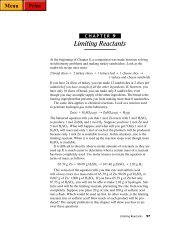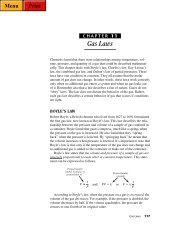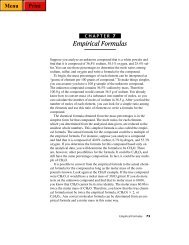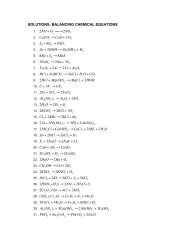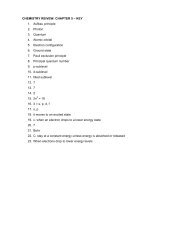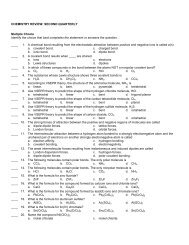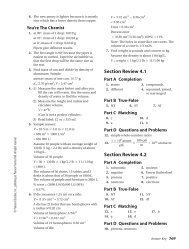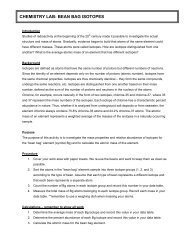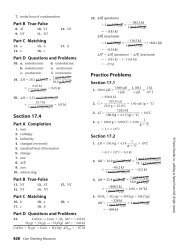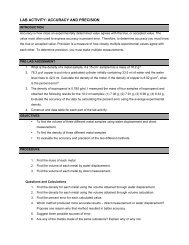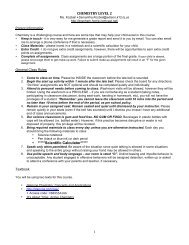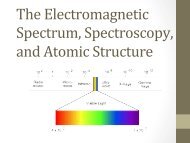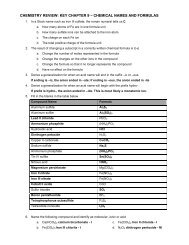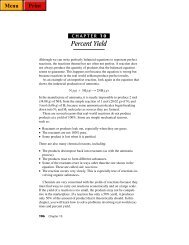Create successful ePaper yourself
Turn your PDF publications into a flip-book with our unique Google optimized e-Paper software.
© Pearson Education, Inc., publishing as Pearson Prentice Hall. All rights reserved.<br />
Section 7.2<br />
Part A Completion<br />
1. electrostatic forces<br />
2. oppositely<br />
3. ionic bonds<br />
4. neutral<br />
5. formula unit<br />
6. crystals<br />
7. high<br />
8. large<br />
9. stable<br />
10. molten<br />
Part B True-False<br />
11. AT 13. AT 15. NT<br />
12. ST 14. ST<br />
Part C Matching<br />
16. b 18. c 20. a<br />
17. e 19. d<br />
Part D Questions and Problems<br />
21. Ionic bonds are the electrostatic forces of<br />
attraction that bind oppositely charged ions<br />
together. In an ionic compound, the positive<br />
charges of the cations equal the negative<br />
charges of the ions.<br />
22. When ionic compounds are melted, the<br />
orderly crystal structure breaks down. Each<br />
ion is then free to move throughout the<br />
molten mass. If a voltage is applied, cations<br />
will migrate to one electrode, and anions will<br />
migrate to the other. This movement of ions<br />
means that there is a flow of electricity<br />
between the two electrodes. When ionic<br />
compounds dissolve in water, their ions are<br />
free to move. Thus, aqueous solutions of ionic<br />
compounds also conduct electricity.<br />
Section 7.3<br />
Part A Completion<br />
1. cations<br />
2. electrons<br />
3. metallic<br />
4. electrical<br />
5. malleable/ductile<br />
6. ductile/malleable<br />
7. body-centered/face-centered<br />
8. face-centered/body-centered<br />
9. hexagonal close-packed<br />
10. alloy<br />
Part B True-False<br />
11. NT 13. NT 15. AT<br />
12. ST 14. AT<br />
Part C Matching<br />
16. d 18. b 20. a<br />
17. e 19. c<br />
Part D Questions and Problems<br />
21. Solid metals consist of closely packed cations<br />
surrounded by free-moving valence<br />
electrons, which make metals good<br />
conductors of electric current. As electrons<br />
enter one end of a bar of metal, an equal<br />
number leave the other end. Metal cations<br />
are insulated from one another by electrons.<br />
When a metal is subjected to pressure, the<br />
metal cations easily slide past one another.<br />
This behavior makes the metal malleable and<br />
ductile.<br />
22. The superior properties of alloys result from<br />
the cumulative properties of all the<br />
constituents of the alloy. For example, an<br />
alloy can be more durable than one<br />
constituent but more malleable than another.<br />
Practice Problems 7<br />
Section 7.1<br />
1. a. (i) 2 (ii) Ba 6 (iii) Ba 2<br />
b. (i) 7 (ii) (iii) I c. (i) 1 (ii) K = (iii) K I<br />
2. a. 3<br />
b. 7<br />
c. 6<br />
3. a. 1s22s22p63s23p64s2 b. 1s 2 2s 2 2p 6 3s 2 3p 5<br />
c. 1s 2 2s 2 2p 6<br />
d. 1s 2 2s 2 2p 6 3s 2 3p 6<br />
e. 1s 2 2s 2 2p 6<br />
4. The number of valence electrons in an atom<br />
of a representative element is the same as the<br />
group number of the element.<br />
Answer Key 781



